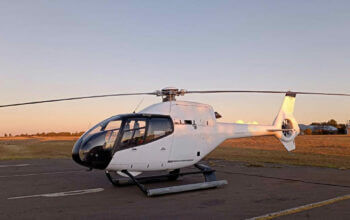Last month, Archer Aviation promised to show that it independently designed its Maker eVTOL before recruiting any employees from competitor Wisk Aero, which has accused Archer of stealing its aircraft design and trade secrets.
Now, Archer has presented its origin story for the Maker, contending that the aircraft was conceived by an independent firm, FlightHouse Engineering, at least a month before Wisk applied to patent a similar design.

The account is contained in Archer’s answer, filed June 1, to a complaint filed April 6 by Wisk, a joint venture between Boeing and Kitty Hawk.
Wisk alleges that the Maker copies a design that Wisk submitted in a confidential patent application to the U.S. Patent and Trademark Office in January 2020. Wisk further contends that some of its employees who left for Archer stole files containing trade secrets that have benefited Archer’s ambitious effort to bring a commercial air taxi to market by 2024, buoyed by an expected $1.1 billion in proceeds from a merger with the blank-check company Atlas Crest Investment Corp (NYSE: ACIC).
Archer’s answer and motion to dismiss are scathing in their criticism of Wisk, claiming that “Wisk is improperly attempting to weaponize the legal system to achieve through bad-faith litigation what it cannot accomplish through fair competition.”
“While Archer has soared, Wisk is at risk of crashing,” Archer’s answer states. “Despite the breathless innuendo and baseless speculation to which Wisk devotes its entire complaint, Archer’s eVTOL aircraft design is not only the best eVTOL aircraft around, it is entirely Archer’s design.”
Archer founders Brett Adcock and Adam Goldstein recruited VP of engineering Tom Muniz from Wisk in late 2019. Muniz formally joined the company in December 2019, and 10 more Wisk engineers left for Archer in January 2020, including the senior power electronics engineer who is alleged to have downloaded nearly 5,000 confidential files from Wisk’s secure corporate Google Drive repository before his abrupt departure.
However, Archer claims that it commissioned the design concept that would become the Maker in September 2019, when it hired FlightHouse Engineering to model a number of potential air taxi designs. FlightHouse was founded in 2016 by Jay Gundlach, who previously worked for Insitu and Aurora Flight Sciences and left FlightHouse earlier this year, and current president Calder Hughes, who was employed as a senior mechanical design engineer for Wisk predecessor Zee.Aero from 2011 to 2014, according to LinkedIn.
FlightHouse did not immediately respond to a request from eVTOL.com for comment. An Archer spokesperson acknowledged that some of the FlightHouse team previously worked at Zee.Aero, but pointed out that this was five years before they began working with Archer and that it is not uncommon in any industry for people to switch jobs.

According to Archer’s June 1 filing, “It was FlightHouse that first presented to Archer the configuration that would become known as the Maker. By early December 2019, FlightHouse modeled a number of aircraft designs, including what FlightHouse referred to as the ‘12-tilt-6’ — an aircraft with 12 rotors on a fixed wing, the front six of which could tilt from a vertical to a horizontal position to allow the aircraft to hover like a helicopter for take-off and landing, and cruise forward like a plane while in flight.”
“To be clear, on the day the first Wisk employee arrived (on December 6), FlightHouse had already modeled the 12-tilt-6 and was actively conducting simulations on this design,” the filing emphasizes. “By December 12, FlightHouse identified the 12-tilt-6 as a top design contender based on the strong performance attributes reflected in simulations run in FlightHouse’s proprietary software.”
Archer says that after its chief engineer, Geoff Bower, joined the company in January 2020, he “carefully evaluated the ‘12-tilt-6’ design presented by FlightHouse along with a handful of other configurations,” and led the decision to ultimately select that configuration for the Maker. Bower was previously chief engineer for Airbus’s Vahana project, which tapped FlightHouse Engineering to design and manufacture composite airframes for its eVTOL demonstrators.
Archer asked United States District Judge William H. Orrick to dismiss Wisk’s complaint, contending that the plaintiff failed to identify its purported trade secrets or plausibly allege that Archer improperly used any Wisk trade secrets. “Wisk’s complaint is long on hyperbole and speculation, but utterly bereft of any legally cognizable claim of the existence of a specific trade secret, let alone its misappropriation by Archer,” its motion to dismiss states.
However, while Wisk provided only a general description of asserted trade secrets in its April 6 complaint, its separate motion for preliminary injunction, filed May 19, contains many more details about the trade secrets that are redacted from public records. Archer asked for a 28-day extension on its time to respond to that motion, which Orrick granted in part; Archer’s opposition to the motion is now due June 23.
In a statement provided to eVTOL.com, Wisk said that Archer’s June 1 filing “confirms the strength of Wisk’s claims, and changes nothing about the case — it contains no substantive response to the allegations Archer misappropriated more than 50 specific Wisk trade secrets, which were disclosed in a court filing last month and cover multiple components, systems, and designs for the aircraft.
“Tellingly, Archer cannot deny that thousands of files were stolen from Wisk by current Archer employees, which contain confidential information especially relevant to the design Archer has touted. And Archer’s filing has no plausible explanation for its development timeline,” Wisk added.
In a June 1 filing with the U.S. Securities and Exchange Commission, Atlas Crest Investment Corp said it is “continuing to review these matters.”








